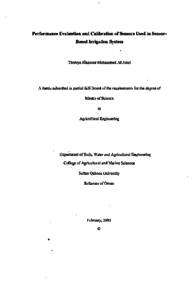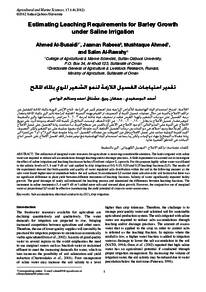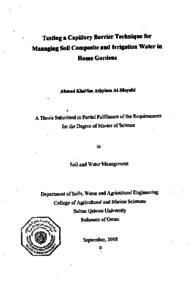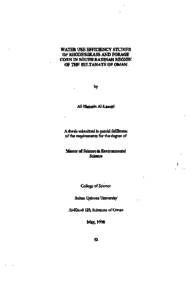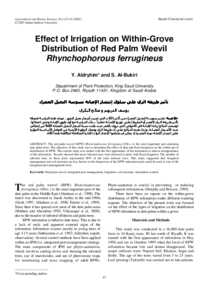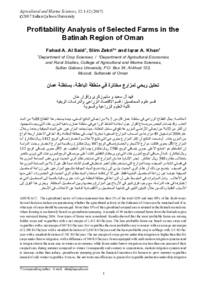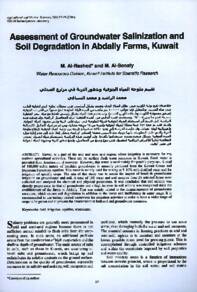Document
Performance evaluation and calibration of sensors used in sensor-based irrigation system
Publisher
Sultan Qaboos University
Gregorian
2015
Language
English
English abstract
Oman is located in an arid climatic zone; annual rainfall ranging from 50 to 300 mm with average of 100 mm. Ground water is the main source of fresh water. More or less 90% of water is consumed by the agricultural production. Most arable lands (48%) are clustered in Al-Batinah region. However, the increased demand of water for agriculture has distressed the water table and recent research findings have revealed that most farm land are being affected by salinity issues, caused by the over pumping for irrigation and seawater intrusion into coastal aquifer in Al-Batinah region. The aim of the research study was to create appropriate methodology to develop modern irrigation systems and proper irrigation scheduling without affecting the farmers and the water table. The aim of the pilot study was to evaluate the performance of the developed sensor-based system, compare and solve the problems related to it. Over- irrigation is one of the problems observed in sensor-based irrigation system in this study. Calibration models for the VH400 sensors were developed as one of the specific objectives.
The developed methodology consisted of four field plots divided according to irrigation systems used; ET-based, time based and two of sensors-based. For ET-based system, historical weather data were used to compute the CWR for okra plant with aid of CROPWAT8.0 software. The time-based system was a modification of ET-based system with timers for irrigation scheduling. While, in sensor-based system, soil moisture sensors (VH400) were used to monitor VWC of soil and to trigger irrigation. The threshold values were obtained using standard methods of estimating FC and PWP. Three replicates were used to calibrate the two VH400 sensors and 5MT sensor in each pot experiment. This was done by saturating the pot and collecting the sensor readings until PWP was reached. Four statistical analysis; R2, MBE, RMSE and K were conducted to test the accuracy of developed calibration models. The main findings of the study were; the graphical representation of the CWR which was in decreasing trend due to the approaching winter in Oman during the crop period. In theory, and based on literature the sensor-based irrigation system is the best for scheduling irrigation followed by ET-based. The amount of water applied during crop period of one month was 3,344 and 3.379 m for ET and Time-based irrigation respectively. The amount of water saved was only 35 liters (1%). Over-irrigation had occurred in the sensor based plots, which made it difficult to analyze its data. In the calibration process, three segmented calibration models were obtained which showed biased error compared to the company provided models. The estimated value for FC and PWP were 37.44% and 12.39% respectively. Statistical analysis showed good accuracy of the developed models. Moreover, the sensors evaluated in this study seem to require unique sensor orientation and soil-specific field calibrations and further investigation are required to verify the performance of the developed models under field conditions.
Member of
Resource URL
Arabic abstract
تقع عمان في المنطقة المناخية الجافة؛ ويتراوح معدل المطر السنوي من 50 إلى 300 ملم مع متوسط 100 ملم. و تعتبر المياه الجوفية هي المصدر الرئيسي للمياه العذبة. أكثر أو أقل من 90% من المياه المستهلكة تكون في الإنتاج الزراعي. معظم الأراضي الصالحة للزراعة التي تمثل نسبة 48 % تقع في منطقة الباطنة وهي أحد المناطق الزراعية المنتجة في عمان. ومع ذلك، فإن زيادة الطلب على المياه للزراعة أخلت بمستوى المياه الجوفية و كشفت نتائج البحوث الأخيرة أن معظم الأراضي الزراعية تأثرت بالملوحة، بسبب ضخ المياه للري وتداخل مياه البحر إلى المياه الجوفية الساحلية في منطقة الباطنة. الهدف من هذه الدراسة هو إيجاد الطريقة المناسبة لتطوير نظم الري الحديثة المناسبة وجدولة الري دون التأثير على المزارعين و المياه الجوفية. وكان الهدف من الدراسة التجريبية تقييم أداء أجهزة الإستشعار ووضع نظام مقارنة وحل المشاكل المتعلقة بها. زيادة الري هو أحد المشاكل التي لوحظت في هذه الدراسة في نظام الري المعتمد على أجهزة الإستشعار. وضع نماذج المعايرة لأجهزة الاستشعار VH400 في هذا البحث هو أحد الأهداف المحددة. المنهجية التي تم وضعها تتكون من أربعة مخططات تقسم على حسب نظام الري المستخدم فيها إلى التوقيتي والتبخر (ET) و أجهزة الإستشعار. بالنسبة لمجال الري المستخدم فيه التبخر ( ET ) تم استخدام بيانات الطقس في حساب احتياجات النبات من الماء لمحصول الباميا بمساعدة برنامج .CROPWAT 8 . 0 . وفي حين أنه في نظام الري القائم على اجهزة الإستشعار فقد تم استخدام مستشعر رطوبة التربة (VH400) لمعرفة مستوى الرطوبة في التربة وفي جدولة الري بناء على قيم محددة. هذه القيم يتم الحصول عليها بإستخدام الطريقة القياسية لمعرفة السعة الحقلية و نقطة الذبول الدائم. وقد تم استخدام ثلاثة نماذج لمعايرة أجهزة الاستشعار باستخدام اثنين من VH400 و واحد من 5MT جهاز استشعار في كل وعاء التجربة. وقد تم هذا من خلال اغراق الأوعية وجمع القراءات حتى وصلت نسبة الرطوبة إلى النقطة الذبول الدائم . وقد تم إجراء أربعة تحاليل إحصائية؛ RMSE ،BMER2 و k لاختبار دقة وضع نماذج المعايرة. النتائج الرئيسية التي توصلت إليها الدراسة؛ الرسم البياني لاحتياج النبات من الماء في تناقص بسبب اقتراب فصل الشتاء في عمان في الفترة زراعة المحصول. أقصى و أدنى قيمة ET7 . 94 و 3 . 13 ملم يوميا على التوالي. ومن الناحية النظرية، مستشعر نظام الري هو أفضل في جدولة الري ويليه ET. كمية المياه المستخدمة في الري خلال الفترة من 27 تشرين الأول/أكتوبر حتى 30 نوفمبر 2014 کان 3. 344 و 379 . 3 مترمكعب من نظام الري ET و التوقيتي على التوالي. وكمية الماء التي تم حفظها لم تتعدى سوى 35 لتر (1 % ). الإفراط في الري قد حصل في قطعة الأرض التي استخدم فيها الأجهزة المستشعرة لجدولة الري مما أدى إلى صعوبة تحليل البيانات. في عملية المعايرة تم الحصول على ثلاثة نماذج مختلفة عن المعايرة المقدمة من قبل الشركة المصنعة لجهاز الاستشعار. وأظهرت النتائج أن النماذج المقدمة من الشركة كانت أقل من المتوقع في تحديد نسبة الرطوبة و التي أدت إلى الإفراط في الري. إن القيمة المقدرة لسعة الحقلية ونقطة الذبول الدائم 44. 37% و 39. 12% على التوالي. وأوضح التحليل الإحصائي دقة جيدة لنماذج المتقدمة. وعلاوة على ذلك، فإن أجهزة الاستشعار في هذه الدراسة يبدو بحاجة إلى تقييم من ناحية توجة جهاز الاستشعار وتحت تركيبات مختلفة من التربة. ويلزم إجراء مزيد من التحقيق للتحقق من أداء النماذج المتقدمة في الظروف الميدانية.
Category
Theses and Dissertations

